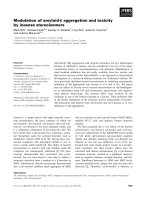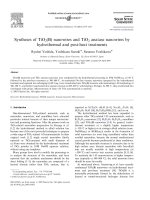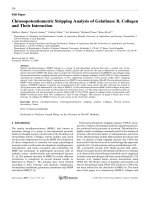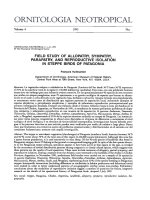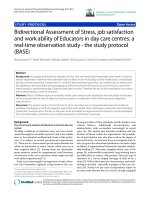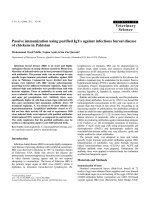Field assessment of the efficacy of M.B., LIBDV and Winterfield 2512 strain vaccines against infectious bursal disease in chickens
Bạn đang xem bản rút gọn của tài liệu. Xem và tải ngay bản đầy đủ của tài liệu tại đây (649.82 KB, 9 trang )
15
Nong Lam University, Ho Chi Minh City
Field assessment of the efficacy of M.B., LIBDV and Winterfield 2512 strain vaccines
against infectious bursal disease in chickens
Ho M. Nguyen1 , Anh T. Quach1∗ , Anh T. T. Le2 , & Hien T. Le1
1
Faculty of Animal Science and Veterinary Medicine, Nong Lam University, Ho Chi Minh City, Vietnam
2
Vetstar, Ho Chi Minh City, Vietnam
ARTICLE INFO
ABSTRACT
Live virus vaccines are very important parts of the prevention of
Infectious Bursal Disease (IBD) in chickens. However, the successful IBD vaccination depends on IBD field pressure, vacciReceived: October 12, 2018
nation technique, the immune status of the chicken, and espeRevised: November 09,2018
cially IBDV strains used in the vaccines which are able to break
Accepted: November 28, 2018
through a higher level of maternal-derived antibodies (MDA).
The objective of this field study was to compare the efficacy
of a new vaccine based on M.B. strain to other commercial vaccines (LIBDV and winterfiled 2512) in terms of speed of antibody
immune response and interference to Newcastle Disease (ND)
Keywords
vaccination. Six houses of broilers, each with 15,000 to 16,000
chickens, were divided into two groups: (1) vaccinated with M.B.
Break through MDA
strain (group A) and (2) vaccinated with LIBDV or 2512 strains
(group B). Blood samples were collected prior to the 1st IBD
Chicken
vaccination, and at 21, 28 and 35 days of age for IBD and ND
M.B. strain
antibodies. Comparison of lesion scores and uniformity of the
Uniformity
bursa of Fabricius (BF) at 28 and 35 days of age was carried out.
Results showed that both groups had good immune responses,
but group A showed significantly higher IBD antibody titers at
28 and 35 days of age. Antibody titers for ND and histopathological lesion scores of the BF were not significantly different
∗
Corresponding author
between the 2 groups. The BF in group A was more uniform and
had fewer lesions when compared with that in group B. In conQuach Tuyet Anh
clusion, the IBD vaccine with an M.B. strain can provide better
Email: immunological efficacy than LIBDV and 2512 strains.
Research Paper
Cited as: Nguyen, H. M., Quach, A. T., Le, A. T. T., & Le, H. T. (2018). Field assessment of the
efficacy of M.B., LIBDV and Winterfield 2512 strain vaccines against infectious bursal disease in
chickens. The Journal of Agriculture and Development 17(6), 15-23.
1. Introduction
For many years, Infectious Bursal Disease
(IBD) has been a serious problem threatening
the poultry industry (Berg, 2000; Alkie & Rautenschlein, 2016). In March 2018, a report from
ILDEX Vietnam showed that 12/64 provinces
(18.75%) in Viet Nam in 2017 had IBD disease
outbreaks. Live vaccines have been proved to be
a powerful tool in controlling Gumboro disease
(Van den Berg et al., 2000; Eterradossi & Saif,
2008; Muller et al., 2012). Currently, There are
www.jad.hcmuaf.edu.vn
3 types of live IBD vaccines available for young
chickens including live attenuated IBD vaccines,
immune complex vaccines, and recombinant vaccines (Gardin et al., 2011; Muller et al., 2012).
However, IBD live vaccine is still a good solution
for high vvIBD challenge areas (Berg & Meulemans, 1991). This type of vaccine protects chickens as the vaccine viruses replicate at the bursa
of fabricius and induce a strong immune reaction
leading to high antibody titers, and the shedding
of vaccine virus to the environment helps reduce
the field virus pressure at farms (Gomes et al.,
The Journal of Agriculture and Development 17(6)
16
2015). In addition, live IBD virus vaccine is very
important for primary vaccination of the pullet.
When stimulating memory cells, it acts as a good
primer to inactivated IBD vaccination (Gardin
et al., 2011). It is necessary to have high IBD
antibody titers in the breeders that then pass
to the offspring protecting them in the first 23 weeks of life (Eterradossi & Saif, 2008; Fantay
et al., 2015). Before the maternal-derived antibodies (MDA) drop too low, vaccinating broilers is really the key to the continuation of the
protection (Fantay et al., 2015; Jackwood, 2017).
For that reason, live IBD vaccines should have
the ability to break through high levels of MDA
to provide as early protection as possible without being neutralized by the MDA (Fantay et al.,
2015). The new IBD vaccine strain in Vietnam
market is M.B., Israeli strain, isolated in 1989
by Abic scientists Drs Barbakov and Gutter. The
name of M.B. was named by these scientists. It
got the United States patent on Sep. 8, 1998 with
the patent number 5804195. The M.B. strain belongs to genetic group 6 (Lazarus et al., 2008) and
is able to break through MDA levels in broilers
of 800 IDEXX ELISA while the normal intermediate IBD vaccines achieve this at a titer of 125
IDEXX ELISA and intermediate plus IBD vaccines at 500 IDEXX ELISA (De Wit, 2001).
The objective of this study was to evaluate the
efficacy of the IBD M.B. vaccine strain and compare it with other commercial vaccines (LIBDV
strain and 2512 strains) in commercial broiler
chickens.
2. Materials and Methods
2.1. Experimental design
Six flocks (A1, A2, B1, B2, B3, and B4) (Figure 1) were kept in environmentally controlled
broiler houses on 2 different commercially operated farms in Xuan Loc, Dong Nai. The flocks
(A1, A2, B1, B2) were raised in farm 2 which
was about 4 kilometers away from farm 1 (B3
and B4 flocks). There were 15,000 - 16,000 broiler
chickens in each house. All chickens in farm 1 and
2 across the groups were subjected to the same
management procedures and housing conditions.
A total of 95,000 day-old-chicks (Ross 308)
used in this study were bought from the same
breeding company, and hence they were assumed
inherited the same MDA. This assumption was
confirmed by testing the amount of MDA in
The Journal of Agriculture and Development 17(6)
Nong Lam University, Ho Chi Minh City
chicks at 2 days old.
Figure 1. Design of experiments.
2.2. Vaccination schedule
There were two vaccination schedules which
were different based on the Gumboro vaccination program (Table 1). All other vaccinations
were exactly the same in both schedules. Schedule B was kept exactly as the vaccination program which was used in this farm for long time. It
was considered as the standard vaccination program which was suitable for the condition and
epidemiology of this farm. Schedule A was new
set up based on the MDA levels at 2 days old.
M.B. strain is able to break through MDA levels of 800 IDEXX ELISA, therefore, in schedule A, the 1st vaccination can be vaccinated as
early as 7-8 days old. While LIBDV strain is able
to break through MDA levels of less than 500
IDEXX ELISA, therefore, in schedule B, the 1st
vaccination should be later (9-10 days old). The
2nd vaccination was 7-10 days after the 1st vaccination (Table 1).
2.3. Serology
Blood samples from twenty chickens per house
were randomly collected immediately prior to the
1st IBD vaccination and subsequently at 21, 28
and 35 days of age for determination of IBD
and ND antibodies. A commercial enzyme-linked
immunosorbent assay kit (IDEXX, Maine, USA,
Cat. number 99-09260) was used as described by
the manufacturer for the detection of antibodies
to IBD in chicken serum. The ND antibody titers
were measured by the haemagglutination inhibition method according to Allan & Gough (1974)
www.jad.hcmuaf.edu.vn
17
Nong Lam University, Ho Chi Minh City
Table 1. Vaccination schedule
Schedule A
M.B. strain
Day old Vaccine1
ND – IB
1
ND kill
7–8
MB (1st )
13
ND – IB
14 – 15 MB (2nd )
27 – 28 ND – IB
Schedule B
LIBDV and 2512 trains
Day old Vaccine1
ND – IB
1
ND kill
9 – 10
LIBDV (1st )
13 – 14 ND – IB
19 – 20 2512 (2nd )
27 – 28 ND – IB
Admission route
Spray
SC
DW
DW
DW
DW
1
SC: Subcutaneous; DW: Drinking water; ND: Newcastle disease; IB: Infectious bronchitis disease.
2.4. Bursa of Fabricius analysis
tion in all houses in farm 2 were not significantly
different (P > 0.05) (Table 2).
Five chickens per house unit were sacrificed at
28 and 35 days of age. Bursa index (BI) was cal- 3.2. Induction of circulating IBD antibodies
post-vaccination
culated as bursa weight / body weight × 100 (Sellaoui et al., 2012). Bursa size vs. spleen size of the
At 28 days of age, circulating ELISA IBD ansame chicken and lesions of BF were observed and
compared among chickens of the same housing tibodies ranged from 227 to 3190 in group A1
(mean titer: 1854, CV: 46%), from 140 to 4648 in
unit.
The BF samples were fixed in 10% formalin group A2 (mean titer: 2431, CV: 47%), from 46
and stained with hematoxylin and eosin described to 3182 in group B1 (mean titer 789, CV: 118%),
from 0 to 4188 in group B2 (mean titer: 500, CV:
by Fischer et al. (2008). Lesions were observed
194%), from 0 to 2315 in group B3 (mean titer:
microscopically and were evaluated based on the
scoring system from 0 to 5 described by Muskett 885, CV:106%) and from 972 to 2638 in group B4
(mean titer: 1787, CV: 34%). At 28 days of age,
et al. (1979).
the induction of an active immune response in
group A were significantly higher than in group
2.5. Statistical analysis
B (P < 0.001) (Table 2). In addition, the antiCollected data were managed and simple calcu- body titers of the majority of samples in group
lation were performed in MS Excel 2010. Random A were above 1500. On the contrary, the antieffect models were used to detect any influence body titers of the majority of samples in group B
of factors: age, or vaccine on antibody levels or were below 1500 (Figure 2). The CV in group A
Bursa indices. These models were built in Stata was also much lower than that in group B (Table
2), which showed that group A was much more
11 with farm factors as random variables.
uniform than group B.
3. Results
3.1. Maternally derived IBD antibodies
Right before the 1st IBD vaccination was applied, 20 serum samples from birds that were randomly selected from each house were measured to
determine their maternal ELISA antibody titers.
The titers ranged from 100 to 2614 in group A1,
from 271 to 2534 in group A2, from 175 to 2320
in group B1 and from 264 to 2673 in group B2.
Although the day of the 1st IBD vaccination was
different among houses (Table 1), the maternal
antibody levels at the day of the 1st IBD vaccina-
www.jad.hcmuaf.edu.vn
At 35 days of age, circulating ELISA IBD antibodies ranged from 682 to 4700 in group A1
(mean titer: 2741, CV: 36%), from 2014 to 3823
in group A2 (mean titer: 2851, CV: 20%), from
802 to 5890 in group B1 (mean titer: 2066, CV:
54%), from 33 to 5721 in group B2 (mean titer:
3127, CV: 51%), from 1346 to 4999 in group B3
(mean titer: 3174, CV: 32%) and from 1027 to
3666 in group B4 (mean titer: 2182, CV: 33%).
The induction of an active immune response in
group A was significantly higher than in group B
(P < 0.01) (Table 2). Again, the CV in group A
was still lower than that in group B (Table 2).
The Journal of Agriculture and Development 17(6)
18
Nong Lam University, Ho Chi Minh City
Table 2. Induction of circulating IBD antibodies
IBD – before vac
IBD – 28 days old
IBD – 35 days old
Group A
M.B. strain
Mean titer CV (%)
1083.62
59.06
2142.25
48.66
2795.77
28.51
N
40
40
40
Group B
LIBDV + 2512 strains
Mean titer CV (%) N
1158.2
49.37
40
991.57
99.47
80
2637.13
47.25
80
P
0.583
0.000
0.010
Figure 2. The serum IBD antibodies of chickens at 28 days old in farm 2.
Table 3. Induction of circulating ND antibodies
ND – 21 days old
ND – 28 days old
ND – 35 days old
Group A
M.B. strain
Mean titer CV (%)
3.30
39.00
3.35
49.00
5.77
32.68
N
20
40
40
Group B
LIBDV + 2512 strains
Mean titer CV (%) N
1.65
49.00
20
3.45
57.39
80
4.17
49.80
80
P
0.000
0.777
0.255
Table 4. Bursa index
28
35
Group A
BI
CV (%)
0.56
26.5
0.49
22.4
N
10
10
Group B
BI
CV (%)
1.02
57.7
0.60
37.3
N
20
20
P
0.015
0.131
ever, at 35 days of age, the BI of both groups
were not significantly different (P > 0.05). Group
A at both 28 and 35 days of age had fewer leAt 21 days of age, the induction of an active ND sions (hemorrhages) than group B (Table 4). All
immune response in group A were significantly data including CV (Table 4), comparing the size
higher than that in group B (P < 0.001). How- of bursa and spleen of the same chicken (Table 5)
ever, at 28 and 35 days of age, the ND antibody showed that the size of the bursa of group A was
titers of both groups were not significantly differ- much more uniformity than group B’s.
ent (P > 0.05) (Table 3).
3.3. Induction of circulating ND antibodies
post-vaccination
3.5. Histopathology studies
3.4. BI and the uniformity and lesions of BF
The score lesions of both groups at 28 and 35
At 28 days of age, the BI of group A was signif- days of age were not significantly different (P >
icantly smaller than group B (P < 0.05). How- 0.05) (Table 6).
The Journal of Agriculture and Development 17(6)
www.jad.hcmuaf.edu.vn
19
Nong Lam University, Ho Chi Minh City
Table 5. Detecting bursa lesions and comparing the size of bursa and spleen of the same chicken
28 days old
Group A Group B
(N=10)
(N=20)
10
20
0
15
Hemorrhage inside (%)
Bigger than spleen (%)
Smaller or same size with spleen’s = normal
size (%)
Bursa atrophy∗ (%)
∗
35 days old
Group A Group B
(N=10)
(N=20)
0
15
0
5
100
75
100
95
0
10
0
0
if BI < 50% of BI average of that flock.
Table 6. Score lesions
Score lesions
28 days old
35 days old
Group A (N=10)
3.1
1.8
Group B (N=20)
2.6
2.2
P
0.249
0.205
4. Discussions
in titer and were protected (group A: 95%; group
B: 85%).
We compared two different IBD vaccination
programs in maternal antibody positive broilers.
Their efficacy by means of rapid and uniform IBD
antibody immune response and interference to
ND vaccination was investigated. Furthermore,
the vaccines induced lesion development and effect on the size of the BF were compared.
Another vaccination strategy to control a disease is to use a vaccine to induce a uniform active
immune response in all individual of the flock. In
this way, the viruses in the field have no chance
to attach, replicate and multiply at an extremely
large number in any chickens. In addition, they
have no chance to infect the other chickens in
that flock. Therefore, a superior vaccine will produce better uniformity (CV is lower). The uniformity of both groups was improved from 28 days
to 35 days of age. At both stages, the uniformity
of group A was better than group B (group A:
48.66% decreased to 28.51%; group B: 99.47% decreased to 47.25%).
Maternally derived IBD antibodies at the day
of the 1st IBD vaccination in all housing units in
farm 2 were checked and they were confirmed not
significantly different. That mean both groups
had the same starting point as the basis for comparing the increase of IBD antibodies later.
Young chickens are protected by maternal antibodies and then by active immunity which is
induced by vaccination. There is a gap of immunity when maternal antibodies decrease to below
protective levels and active immunity has not increased to the level of protection (Le Gros et al.,
2009). To shorten this gap, a better IBD vaccine
will be able to induce antibodies faster (Jackwood
& Sommer, 1999; Van den Berg et al., 2000).
Our study showed that the M.B. strain vaccine
was able to induce faster and higher IBD antibody titers (Figure 2). If we choose the titer 1500
which is the titer of live IBD vaccines protecting
against IBDV infection as the baseline (Bughio
et al., 2017), at 28 days old, most of the chickens
in group A had a titer above 1500 (72.5%), while
most of the chickens in group B had a titer below
1500 (only 30% above 1500) (Figure 2 & 3). At
35 days of age, both groups had a good increase
www.jad.hcmuaf.edu.vn
The IBD is characterized by immunosuppression and mortality in chickens of 3 to 6 weeks
of age (Eterradossi & Saif, 2008; Sellaoui et al.,
2012; Khenenou et al., 2017). Therefore, one of
the common concerns for using live IBD vaccines
is the cause of immunosuppression. At this young
age, if chickens have immunosuppression, they
will not be able to induce an immune response
to other antigens such as ND (Allan et al., 1972;
Van den Berg et al., 2000). In this study, both
groups were using the same ND vaccine program.
At 21days of age, group A had a statistically
higher ND titers (P < 0.001) and more uniformity than group B (Table 3). Hence, the M.B.
strain vaccine did not adversely affect immune response ability. It also may increase the health of
the chickens, which enabled the chickens to have
a better immune response to ND (Figure 4).
The Journal of Agriculture and Development 17(6)
20
Nong Lam University, Ho Chi Minh City
Figure 3. Induction of circulating IBD antibodies.
Figure 4. Induction of circulating ND antibodies.
The target organ of IBD viruses is the BF
(Khenenou et al., 2017; Farhanah et al., 2018).
IBD viruses need to travel through the chicken’s
body and only when they locate in the BF, will
they be able to replicate and infect the chicken
(Farhanah et al., 2018). During the gap of immunity, the chickens are at high risk for IBD
infection due to the low level of both maternal
antibody and humoral immunity (Lazarus et al.,
2008; Le Gros et al., 2009). At this stage, a good
The Journal of Agriculture and Development 17(6)
IBD vaccine will protect chickens by rapidly locating the vaccine viruses in BF leaving no space
left in the BF for field viruses to locate. Therefore, during the gap of immunity, the speed of location of vaccine viruses in BF is very important
to protect chickens from IBD (Rautenshlein et al.,
2005). In other words, a better IBD vaccine has
a faster location of its vaccine viruses in the BF.
During the development of the chicken, its BF is
shrinking over time. It can also shrink due to the
www.jad.hcmuaf.edu.vn
21
Nong Lam University, Ho Chi Minh City
Figure 5. Sub clinical sign of BF and bursa size vs. spleen size.
location and replication of IBD viruses (Moraes et
al., 2004). When the chickens are vaccinated with
live IBD vaccine, these vaccine viruses are replicating in the bursa. As a result of this replication,
the chicken’s immune system is reacting with a
humoral antibody response, which will protect
the bird from the field strain. One of the signs
of this replication is a change in the bursa size –
the bursa is getting smaller (Moraes et al., 2004;
Eterradossi & Saif, 2008). Therefore, the bursa
size of a good IBD vaccine is smaller than normal
and it has to be uniform, which means the vaccine
provides good titer uniformity leading to uniformity in protection. When the bursa size is not
uniform this means the protection is not uniform
leading to poor protection and IBD can be sub-
www.jad.hcmuaf.edu.vn
clinical or you may have a clinical outbreak. Our
study found that at 28 days of age, the BI and CV
of group A was smaller than group B, but at 35
days of age, the BI of both groups were similar.
This indicated that the LIBDV and 2512 strains
located and replicated in the BF later than the
M.B. strain. They could only catch up with the
M.B. strain at 35 days of age. However, in both
stages (28 and 35 days), The M.B. strain was always more uniform than the other strains. Consistently, all data in Table 5 and Figure 5 indicated
that the M.B. strain had better uniformity. One
more time, it was confirmed that the IDB antibody titers of group A were much more uniform
than group B (Figure 2).
The Journal of Agriculture and Development 17(6)
22
5. Conclusions
Comparing different vaccine strains (M.B.
strain vs. LIBDV and 2512 strain), the M.B.
strain produced better protection for IBD in
terms of shortening the immune gap, locating earlier in the BF, inducing higher and more uniform
immune responses, and not causing immunosuppression.
References
Alkie, T. N., & Rautenschlein, S. (2016). Infectious bursal disease virus in poultry: current status and future
prospects. Veterinary Medicine: Research and Reports
7, 9-18.
Allan, W. H., Faragher, J. T., & Cullen, G. A. (1972).
Immunosuppression by the infectious bursal agent in
chickens immunized against Newcastle disease. The
Veterinary Record 90(18), 511-512.
Allan, W. H., & Gough, R. E. (1974). A standard haemagglutination inhibition test for Newcastle disease. (1) A
comparison of macro and micro methods. Veterinary
Record 95(6), 120-123.
Nong Lam University, Ho Chi Minh City
Fischer, A. H., Jacobson, K. A., Rose, J., & Zeller,
R. (2008). Paraffin embedding tissue samples for sectioning. Cold Spring Harb Protoc.
Doi:10.1101/pdb.prot4989.
Gardin, Y., Palya, V., Cazaban, C., Lozano, F.,
Alva, B., El Attrache, J., & Dorsey, M. K.
(2011). Vaccines and vaccinations against Gumboro disease: the key points. Retrieved September 29, 2018, from />Gomes, L., Ashash, U., & Banet-Noach, C. (2015).
A field study on broiler flocks in Brazil to
evaluate zootechnical parameters, molecular epidemiology, and condemnation index with the use
of Live IBD Vaccine versus HVT-IBD Vector
Vaccine. Retrieved September 29, 2018, from
/>Jackwood, D. (2017). Optimizing immunity in
‘no antibiotics ever’ and ‘reduced use’ broiler
flocks. Retrived September 29, 2018, from
/>
Berg, T. P. (2000). Acute infectious bursal disease in
poultry: a review. Avian Pathology 29(3), 175-194.
Jackwood, D. J., & Sommer, S. E. (1999). Restriction
fragment length polymorphisms in the VP2 gene of infectious bursal disease viruses from outside the United
States. Avian Diseases 43(2), 310-314.
Berg, T. P., & Meulemans, G. (1991). Acute infectious
bursal disease in poultry: protection afforded by maternally derived antibodies and interference with live
vaccination. Avian Pathology 20(3), 409-421.
Khenenou, T., Bougherara, M., Melizi, M., & Lamraoui,
R. (2017). Histomorphological Study of the Bursae of
Fabricius of Broiler Chickens during Gumboro Disease
in Algeria Area. Global Veterinaria 18(2), 132-136.
Bughio, E., Jatoi, A. S., Memon, M., Bughio, R., Khoso,
P. A., Khoso, Z. A., & Baloch, A. A. (2017). Effect
of age and route of administration on the efficacy of
live infectious bursal disease vaccines in broiler. Sarhad
Journal of Agriculture 33, 232-239.
Lazarus, D., Pasmanik-Chor, M., Gutter, B., Gallili, G.,
Barbakov, M., Krispel, S., & Pitcovski, J. (2008). Attenuation of very virulent infectious bursal disease
virus and comparison of full sequences of virulent and
attenuated strains. Avian Pathology 37(2), 151-159.
De Wit, J . J. (2001). Gumboro disease: estimation of optimal time of vaccination by the Deventer formula. Annual Report and Proceedings of COST Action 839: Immunosuppressive Viral Diseases in Poultry (170-178).
Deventer, the Netherlands: Animal Health Service.
Le Gros, F. X., Dancer, A., Giacomini, C., Pizzoni, L.,
Bublot, M., Graziani, M., & Prandini, F. (2009). Field
efficacy trial of a novel HVT-IBD vector vaccine for
1-day-old broilers. Vaccine 27(4), 592-596.
Eterradossi, N., & Saif, Y. M. (2008). Infectious Bursal
Disease. In Swayne, D. E. (Ed.). Disease of poultry
(13th ed., 219-245). Iowa, USA: John Wiley & Sons.
Fantay, H., Balcha, E., Tesfay, A., & Afera, B. (2015). Determining optimum time for administration of live intermediate vaccine of infectious bursal disease to chickens at mekelle farm. Journal of Veterinary Science and
Technology 6(3), 223.
Farhanah, M. I., Yasmin, A. R., Khanh, N. P., Yeap,
S. K., Hair-Bejo, M., & Omar, A. R., (2018). Bursal
immunopathology responses of specific pathogen free
chickens and red jungle fowl infected with very virulent infectious bursal disease virus. Archives of Virology 163(8), 2085-2097.
The Journal of Agriculture and Development 17(6)
Moraes, H., Salle, C., Padilha, A., Nascimento, V., Souza,
G., Pereira, R., Artencio, J., & Salle, F. (2004). Infectious bursal disease: evaluation of pathogenicity of
commercial vaccines from Brazil in specific pathogen
free chickens. Brazilian Journal of Poultry Science
6(4), 243-247.
Muller, H., Mundt, E., Eterradossi, N., & Islam, M. R.
(2012). Current status of vaccines against infectious
bursal disease. Avian pathology 41(2), 133-139.
Muskett, J., Hopkins, I., Edwards, K., & Thornton,
D. (1979). Comparison of two infectious bursal
disease vaccine strains: efficacy and potential hazards
in susceptible and maternally immune birds. The
Veterinary Record 104(15), 332-334.
www.jad.hcmuaf.edu.vn
Nong Lam University, Ho Chi Minh City
Rautenschlein, S., Kraemer, C. H., Vanmarke, J., &
Montiel, E. (2005). Protective efficacy of intermediate
and intermediate plus infectious bursal disease virus
(IBDV) vaccines against very virulent IBDV in commercial broilers. Avian Disseases 49(2), 231-237.
23
Van den Berg, T. P., Eterradossi, N., Toquin, D., &
Meulemans, G. (2000). Infectious bursal disease (Gumboro disease). Revue scientifique et technique 19(2),
509-543.
Sellaoui, S., Alloui, N., Mehenaoui, S., & Djaaba, S.
(2012). Evaluation of size and lesion scores of bursa
cloacae in broiler flocks in Algeria. Journal of World’s
Poultry Research 2(3), 37-39.
www.jad.hcmuaf.edu.vn
The Journal of Agriculture and Development 17(6)

